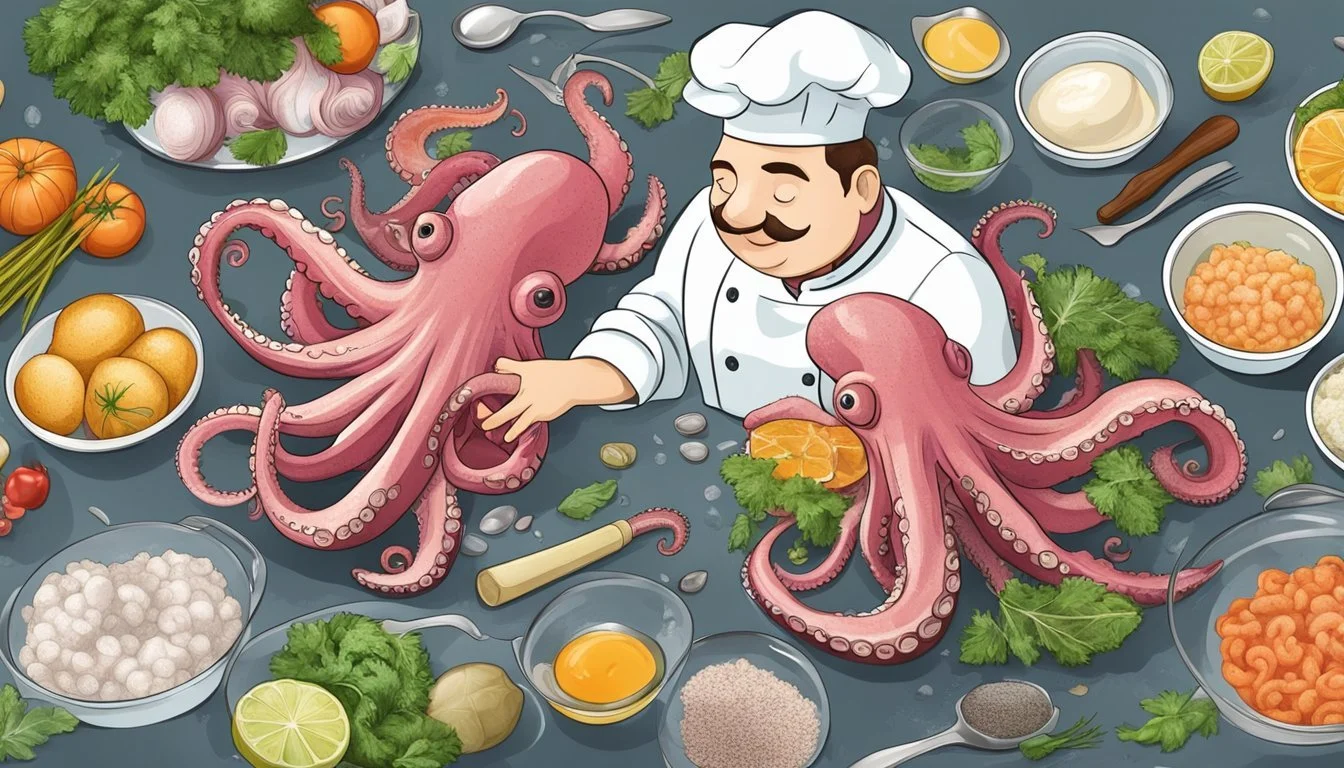Frozen vs Fresh Octopus: A Tentacled Taste Test
When it comes to choosing between frozen and fresh octopus, many seafood enthusiasts might assume that fresh is always superior. However, this belief doesn't hold true for octopus. Frozen octopus often yields more tender results than its fresh counterpart due to the freezing and thawing process, which initiates tenderization.
Frozen octopus is widely available and convenient, typically sold whole and cleaned of viscera. The freezing process not only helps tenderize the meat but also makes it more accessible to consumers who don't live near coastal areas. Fresh octopus, while less common, can be found in some markets but may require additional preparation steps.
Both frozen and fresh octopus offer unique advantages. Frozen octopus provides consistency and convenience, while fresh octopus allows for immediate use and potentially more control over the initial preparation process. Regardless of the choice, proper cooking techniques are essential to achieve the desired tenderness and flavor in octopus dishes.
Nutritional Profile
Octopus is a nutrient-dense seafood option, low in calories and fat while high in protein. It provides essential vitamins and minerals that contribute to overall health and well-being.
Nutrition Facts
A 3-ounce (85-gram) serving of cooked octopus contains approximately 139 calories, 25 grams of protein, and only 2 grams of fat. It's also a good source of carbohydrates, with about 4 grams per serving.
Octopus is rich in vitamins and minerals. It provides significant amounts of vitamin B12, selenium, and iron. The nutritional content is similar between fresh and frozen octopus, as freezing preserves most nutrients.
Here's a breakdown of key nutrients in a 3-ounce serving of cooked octopus:
Calories: 139
Protein: 25g
Fat: 2g
Carbohydrates: 4g
Vitamin B12: 36% of Daily Value (DV)
Selenium: 90% of DV
Iron: 17% of DV
Health Benefits
The high protein content in octopus supports muscle growth and repair. Its low-fat profile makes it an excellent choice for those watching their calorie intake or managing their weight.
Octopus is an excellent source of omega-3 fatty acids, which are known to promote heart health and reduce inflammation. These essential fats may also support brain function and eye health.
The vitamin B12 in octopus is crucial for nerve function and the formation of red blood cells. Selenium acts as a powerful antioxidant, protecting cells from damage. Iron is essential for oxygen transport throughout the body.
Octopus is also a good source of taurine, an amino acid that may help lower cholesterol levels and improve heart health. Its high protein and low calorie content can aid in satiety, potentially supporting weight management efforts.
Sourcing Octopus
Obtaining high-quality octopus is crucial for culinary success. Both fresh and frozen options have their merits, with availability and intended use being key factors to consider.
Choosing Fresh Octopus
Fresh octopus can be found at specialized fishmongers and seafood markets. Look for specimens with firm, intact skin and a mild ocean scent. Avoid those with an overly fishy odor or slimy texture.
The eyes should be clear and bulging, indicating freshness. Check that the tentacles are intact and undamaged. Fresh octopus typically has a pale grayish-pink color.
Ask the fishmonger about the catch date and origin to ensure maximum freshness. Keep in mind that truly fresh octopus may be challenging to find inland or out of season.
Buying Frozen Octopus
Frozen octopus is widely available and often preferred by chefs. Many high-end restaurants, including Four Seasons, opt for frozen octopus due to its consistent quality and tenderness.
The freezing process breaks down muscle fibers, resulting in a more tender texture when cooked. Look for individually quick-frozen (IQF) octopus for the best quality.
When purchasing, check for signs of freezer burn or ice crystals, which may indicate improper storage. Choose packages with clear labeling, including catch method and origin.
Frozen octopus can be stored for extended periods, offering convenience and year-round availability. Thaw slowly in the refrigerator before use for optimal results.
Preparation Basics
Proper preparation is crucial for cooking octopus. This involves cleaning the octopus, removing the ink sac, and dealing with internal organs and beak. These steps ensure the octopus is ready for cooking and will result in the best flavor and texture.
Cleaning the Octopus
Start by rinsing the octopus under cold running water. Gently scrub the skin to remove any debris or sand. Pay special attention to the suckers, as they can trap particles.
For frozen octopus, thaw it in the refrigerator overnight before cleaning. Once thawed, pat dry with paper towels.
Inspect the octopus for any remaining viscera or tough outer skin. Remove these if present, but be careful not to damage the flesh.
Removing the Ink Sac
Locate the ink sac in the body cavity of the octopus. It's a small, dark sac near the internal organs.
Carefully cut around the ink sac with a sharp knife. Take care not to puncture it, as the ink can stain your hands and work surface.
Gently pull out the ink sac and discard it. If you accidentally rupture the sac, rinse the octopus thoroughly to remove the ink.
Internal Organs and Beak
Turn the octopus body inside out to access the internal organs. Remove any remaining organs with your fingers or a spoon.
Locate the beak at the center where the tentacles meet. It looks like a small, hard, white structure.
Push the beak out from the inside of the octopus. Use a sharp knife to cut it away from the surrounding flesh.
Rinse the octopus again after removing the organs and beak to ensure all unwanted parts are gone.
Tenderizing Techniques
Tenderizing octopus is crucial for achieving a soft, palatable texture. Several methods can break down tough muscle fibers and collagen.
Physical Methods
Mechanical tenderizing involves physically breaking down octopus tissue. A meat tenderizer or mallet can be used to pound the octopus, softening its flesh. Some chefs swear by the wine cork method, where corks are added to the cooking water.
Massaging the octopus is another effective technique. Gently kneading the meat for 10-15 minutes can help relax the muscles.
Blanching is also popular. Dip the octopus in boiling water for 30 seconds, then immediately into ice water. Repeat this process 2-3 times.
Chemical Methods
Acids can break down octopus proteins effectively. Marinating in lemon juice, vinegar, or wine for 1-2 hours can significantly tenderize the meat.
Enzymes found in certain fruits like papaya or kiwi can also soften octopus. Apply a paste of these fruits to the octopus for 30 minutes before cooking.
Salt is another tenderizing agent. Rubbing the octopus with coarse salt for 30 minutes, then rinsing, can help break down tough fibers.
Freezing and Thawing
Freezing octopus can actually improve its texture. The ice crystals formed during freezing rupture cell membranes, naturally tenderizing the meat.
For best results, freeze fresh octopus for at least 24 hours. Thaw it slowly in the refrigerator over 1-2 days.
Pre-frozen octopus is often more tender than fresh. The freezing process at sea helps break down connective tissues, resulting in a softer texture when cooked.
Cooking Methods
Octopus can be prepared using various techniques to achieve tender, flavorful results. Each method imparts unique textures and tastes to the meat.
Boiling Octopus
Boiling is a popular method for cooking octopus. Start by placing the octopus in a large pot of cold water. Bring the water to a simmer over medium heat. Cook for 45-60 minutes, depending on size, until tender.
To test doneness, pierce the thickest part with a fork. It should easily slide through. Once cooked, remove from water and let cool slightly. The skin can be easily rubbed off with a paper towel.
Boiling helps tenderize the meat and creates a mild flavor. This method works well for both fresh and frozen octopus. The resulting texture is soft and suitable for various dishes.
Grilling Octopus
Grilling adds a smoky flavor and crispy texture to octopus. Pre-cook the octopus by boiling until tender. Pat dry and brush with olive oil. Season with salt and pepper.
Preheat the grill to high heat. Grill octopus for 3-4 minutes per side until charred. The tentacles will curl and develop a crispy exterior while remaining tender inside.
Grilled octopus pairs well with lemon juice and herbs. This method enhances the natural flavors of the meat. It's best suited for larger octopus pieces or whole tentacles.
Sautéing Octopus
Sautéing is quick and ideal for smaller octopus pieces. Cut pre-cooked octopus into bite-sized chunks. Heat olive oil in a pan over medium-high heat.
Add octopus pieces and cook for 2-3 minutes, stirring occasionally. The exterior will become golden and slightly crispy. Add garlic, herbs, or spices for extra flavor.
This method preserves the octopus's tenderness while adding a pleasant sear. It's perfect for incorporating into pasta dishes or salads. Sautéed octopus has a firmer texture compared to boiled.
Roasting Octopus
Roasting creates a tender interior with a caramelized exterior. Preheat the oven to 375°F (190°C). Place pre-cooked octopus in a baking dish. Drizzle with olive oil and season with salt, pepper, and herbs.
Roast for 15-20 minutes, turning once halfway through. The octopus will develop a golden-brown color and slightly crisp edges. Let rest for a few minutes before serving.
This method concentrates flavors and produces a rich taste. Roasted octopus works well as a main dish or appetizer. It pairs nicely with roasted vegetables or potatoes.
Flavor Enhancements
Enhancing the flavor of octopus, whether frozen or fresh, can elevate its taste and texture. Key ingredients and techniques can transform this seafood into a delectable dish.
Marinades and Herbs
Marinades work wonders for octopus. A simple olive oil and garlic marinade infuses rich flavors. Fresh herbs like parsley, thyme, and oregano add aromatic depth.
For a Mediterranean twist, combine lemon zest, olive oil, and rosemary. This mixture complements the natural taste of octopus without overpowering it.
Marinating time varies. For frozen octopus, 2-4 hours suffices. Fresh octopus benefits from longer marination, up to 8 hours.
A dry rub of salt, pepper, and paprika creates a flavorful crust when grilled. This method works well for both frozen and fresh octopus.
Acidic Additions
Acidic ingredients tenderize octopus and brighten its flavor. Lemon juice is a classic choice. Its citrusy notes cut through the richness of the meat.
White wine vinegar or apple cider vinegar offer tangy alternatives. These acids break down tough fibers, especially in frozen octopus.
A quick pickle of red onions in vinegar adds crunch and acidity. This garnish balances the octopus's texture and taste.
For a Spanish-inspired dish, simmer octopus in a mixture of water, vinegar, and bay leaves. This technique infuses flavor while cooking.
Capers and olives provide bursts of briny acidity. They pair well with grilled or braised octopus, enhancing its natural flavors.
Recipe Ideas
Octopus lends itself to a variety of delicious preparations. From simple appetizers to hearty main courses, this versatile seafood shines in many culinary applications.
Appetizer Options
Grilled octopus skewers make an excellent starter. Marinate bite-sized pieces in olive oil, lemon, and herbs before grilling until lightly charred. Serve with a zesty dipping sauce.
Octopus carpaccio offers a light, refreshing option. Thinly slice cooked octopus and arrange on a plate. Drizzle with high-quality olive oil and a squeeze of lemon juice. Garnish with capers and fresh parsley.
For a Spanish-inspired tapa, try pulpo a la gallega. Boil octopus until tender, then slice and serve over boiled potatoes. Sprinkle with paprika and sea salt, then drizzle with olive oil.
Main Course Creations
Octopus stew is a comforting dish perfect for cooler weather. Simmer octopus with tomatoes, red wine, and aromatic vegetables until tender. Serve over creamy polenta or crusty bread.
Grilled whole octopus makes an impressive centerpiece. Boil the octopus first to tenderize, then grill over high heat until crispy on the outside. Serve with lemon wedges and aioli.
For a Mediterranean-inspired meal, try braised octopus with olives and capers. Slow-cook the octopus with white wine, herbs, and briny ingredients until meltingly tender.
Salads and Pasta
Octopus salad is a light and refreshing option. Combine cooked, chilled octopus with crisp vegetables like celery and bell peppers. Dress with a simple vinaigrette of olive oil and lemon juice.
For a heartier salad, mix grilled octopus with roasted potatoes, cherry tomatoes, and arugula. Toss with a garlic-herb dressing for added flavor.
Pasta dishes showcase octopus beautifully. Try linguine with octopus ragu, where tender octopus is slow-cooked with tomatoes and herbs. Or make a simple spaghetti with octopus, garlic, and olive oil.
Serving and Presentation
Octopus dishes offer diverse presentation options, allowing for creative and appetizing displays. Proper plating techniques and thoughtful garnishes enhance the visual appeal and complement the octopus's flavors.
Plating Techniques
Arrange cooked octopus tentacles in a circular pattern on round plates for an elegant look. Fan out the tentacles from the center, creating a visually striking sunburst effect. For a rustic presentation, place grilled octopus on a wooden board with lemon wedges.
Slice the tentacles into bite-sized pieces and stack them vertically for a modern twist. This method works well for appetizers or tapas-style servings.
For salads, cut the octopus into smaller segments and scatter them throughout the greens. This ensures even distribution and allows the octopus to blend with other ingredients.
Garnishes and Accompaniments
Fresh lemon wedges are essential garnishes for octopus dishes. Their bright acidity cuts through the richness and enhances the seafood's natural flavors. Sprinkle chopped parsley or cilantro over the plated octopus for a pop of color and freshness.
Serve grilled octopus with a side of crisp greens or a light vegetable slaw. These accompaniments provide textural contrast and balance the dish.
For Mediterranean-inspired presentations, include olives, cherry tomatoes, and feta cheese alongside the octopus. Drizzle high-quality olive oil over the plate before serving to add a luxurious touch.
Consider offering dipping sauces like aioli or romesco on the side. These complement the octopus's flavors and provide additional taste dimensions for diners to explore.
Comparative Analysis
Fresh and frozen octopus differ in several key aspects that impact their quality, cooking properties, and sensory attributes. These differences stem from the freezing process and subsequent thawing.
Fresh vs Frozen Quality
Fresh octopus maintains its original texture and flavor profile. It has a firmer consistency and a more pronounced oceanic taste. The meat appears translucent with a slight sheen.
Frozen octopus undergoes changes during the freezing process. Ice crystals form within the tissue, breaking down some of the muscle fibers. This results in a softer texture upon thawing.
Studies have shown that frozen octopus tends to be more tender after cooking compared to its fresh counterpart. The freezing process acts as a natural tenderizer, making the meat less chewy.
Impact on Cooking Time
Fresh octopus typically requires longer cooking times to achieve tenderness. Chefs often employ techniques like massaging or beating the meat to break down tough fibers.
Frozen octopus generally cooks faster due to the structural changes caused by freezing. The broken-down muscle fibers allow heat to penetrate more easily, reducing overall cooking time.
This time-saving aspect makes frozen octopus a popular choice in many commercial kitchens. It allows for quicker preparation without sacrificing quality.
Texture and Flavor Differentials
Fresh octopus offers a firmer bite and a more pronounced seafood flavor. The texture can be described as slightly chewy but tender when properly prepared.
Frozen octopus tends to have a softer, more delicate texture. The freezing process can slightly mute the natural flavors, but this is often imperceptible to most consumers.
Taste tests have shown that many people cannot distinguish between well-prepared fresh and frozen octopus in blind tastings. The cooking method often has a greater impact on flavor than the initial state of the octopus.
Size can affect texture in both fresh and frozen varieties. Smaller octopuses are generally more tender, while larger ones may require additional tenderizing techniques.







